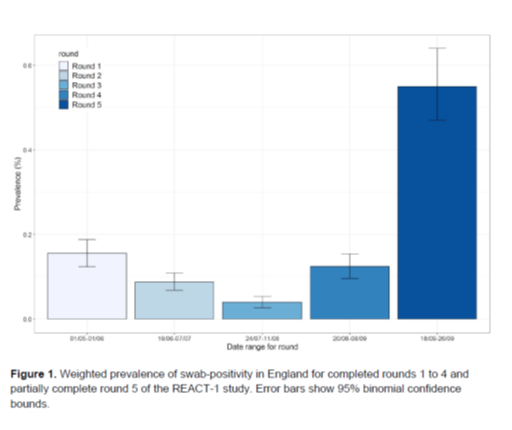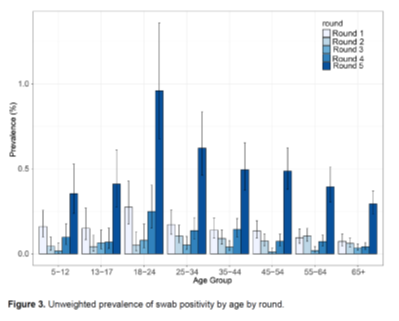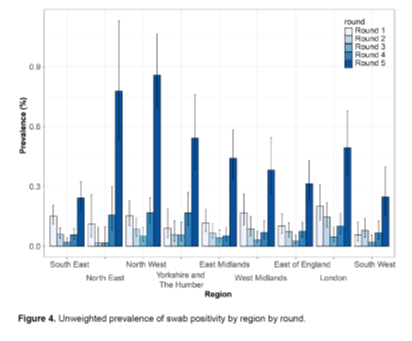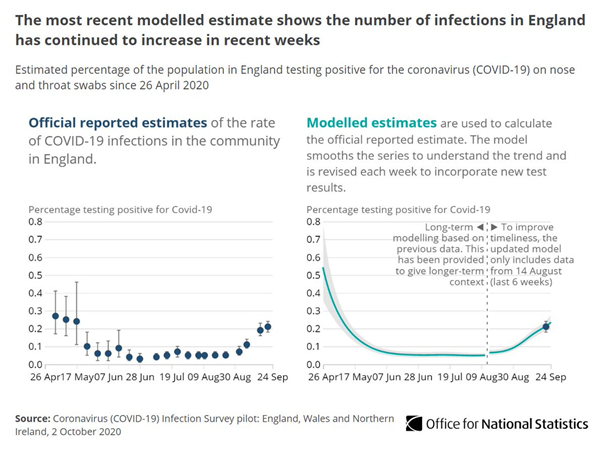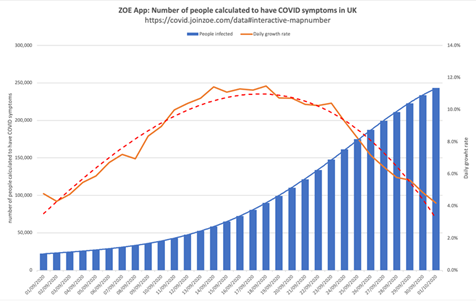Good and bad news from the latest data – and the first evidence that the current measures appear to be working and that we can control the virus without a national lockdown and while keeping schools and the economy open.
3 independent studies (the REACT-1 study from Imperial, the COVID Symptom Study (CSS) from Kings and the weekly ONS infection survey) published in the last 2 days have shown broadly similar trends.
First the bad news:
Infections did rise quickly in September (especially at the beginning) to levels now not seen since May – confirming that the virus still has the potential to spread very quickly.
REACT estimates about 1 in 200 people have the virus now vs. 1 in 1000 in May
Infections did rise quickly in September (especially at the beginning) to levels now not seen since May – confirming that the virus still has the potential to spread very quickly.
REACT estimates about 1 in 200 people have the virus now vs. 1 in 1000 in May
Prevalence of infection has increased in all age groups - including the most vulnerable aged 65+ - leading inevitably to the recent increases in hospitalisations and deaths.
The ONS survey has shown a similar trend of increasing cases over the last month and estimates that about 1 in 500 people were infected over the last week versus 1 in 2000 at the end of August.
(This is not due to increased testing, or changes in the people being tested or higher numbers of false positives – both REACT and ONS use random household surveys – and it is the proportion that are testing positive that has increased.)
There is good agreement between REACT which includes symptomatic and asymptomatic infections (400,000 overall in REACT, half symptomatic) and the COVID Symptom Study (about 200,000 symptomatic).
The number of infections is much higher than that being picked up by NHS test & trace (about 60,000 in last 2 weeks) which means that many cases are still being missed – and shows we cannot rely on it alone to control the spread of the virus.
But the good news is:
This is not a repeat of the first wave – cases are rising much more slowly, doubling roughly every 10 days now vs. 3 days then) and about 1 in 30 of us were infected at the peak in the second half of March.
This is not a repeat of the first wave – cases are rising much more slowly, doubling roughly every 10 days now vs. 3 days then) and about 1 in 30 of us were infected at the peak in the second half of March.
And all 3 studies are showing that the rate of increase is slowing down significantly.
REACT 1 estimate that R has fallen from 1.7 at the beginning of September to around 1.1 (albeit with a wide range of uncertainty 0.7 to 1.5).
ONS figures also show this:
REACT 1 estimate that R has fallen from 1.7 at the beginning of September to around 1.1 (albeit with a wide range of uncertainty 0.7 to 1.5).
ONS figures also show this:
Most importantly, this is the first good evidence we have from the UK that it is possible to slow the spread of the virus without a national lockdown (there was some evidence from modelling that showed that social distancing & self-isolation prior to the lockdown did the same).
Although it is too early to be certain, the current measures appear to be working, and show that we can control the virus without a national lockdown and while keeping schools and the economy open.
In conclusion, if we follow the rules & persist with social distancing, self-isolation, etc., we can keep cases down & save lives (not just from COVID but from all causes by keeping the whole NHS open) and livelihoods & avoid a second lockdown with its disastrous consequences.
So no room for complacency but also reasons to be hopeful...
References:
https://www.imperial.ac.uk/medicine/research-and-impact/groups/react-study/real-time-assessment-of-community-transmission-findings/">https://www.imperial.ac.uk/medicine/...
https://covid.joinzoe.com/data ">https://covid.joinzoe.com/data"...
https://www.ons.gov.uk/peoplepopulationandcommunity/healthandsocialcare/conditionsanddiseases/bulletins/coronaviruscovid19infectionsurveypilot/englandwalesandnorthernireland2october2020">https://www.ons.gov.uk/peoplepop...
References:
https://www.imperial.ac.uk/medicine/research-and-impact/groups/react-study/real-time-assessment-of-community-transmission-findings/">https://www.imperial.ac.uk/medicine/...
https://covid.joinzoe.com/data ">https://covid.joinzoe.com/data"...
https://www.ons.gov.uk/peoplepopulationandcommunity/healthandsocialcare/conditionsanddiseases/bulletins/coronaviruscovid19infectionsurveypilot/englandwalesandnorthernireland2october2020">https://www.ons.gov.uk/peoplepop...

 Read on Twitter
Read on Twitter